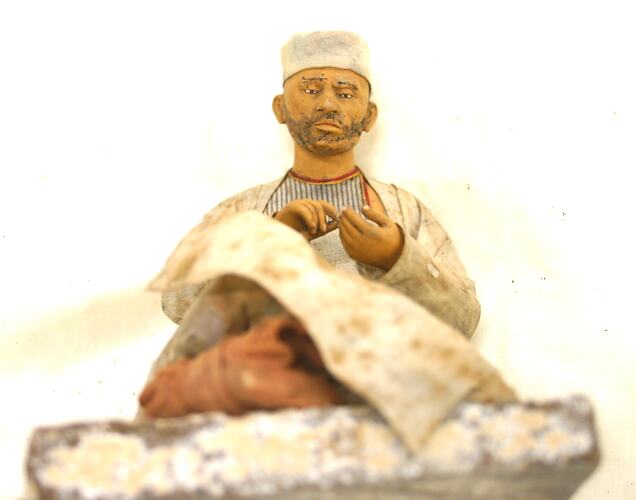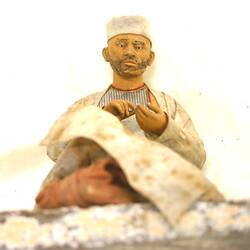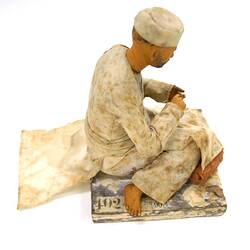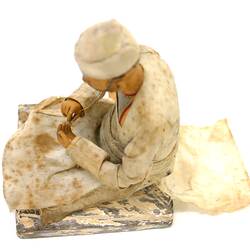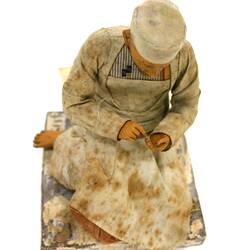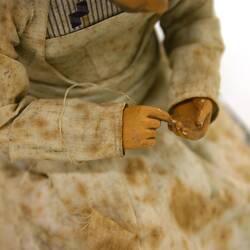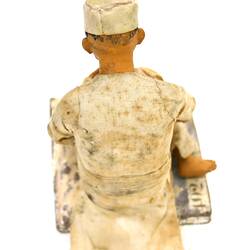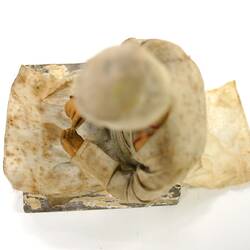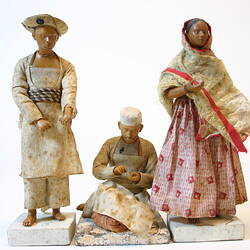Summary
Alternative Names: Poonah Figure, Poona Figure
Clay figure of a Mendicant Priest was made in Krishnanagar province, India. It was exhibited at the Melbourne International Exhibition in 1880, as part of a group of figures representing various castes, occupations and religious sects in India. It was gifted to the National Gallery of Victoria (NGV) by the India Commission of the Melbourne International Exhibition, 1880-81. The figure is identified in the NGV Stock book as a 'Mendicant Priest'.
Krishnanagar clay modeling began in the mid-1700s when the Raja Krishnachandra settled potters from Dacca (East Bengal) and Natore (North Bengal) in Ghurni, a suburb of Krishnanagar in West Bengal. The introduction of Barawari Puja (community worship) in the late 18th century encouraged a shift from the traditional, highly stylized modes of worship practiced by the higher castes to more inclusive and relaxed festivals. Figurative tableaux of clay figures, in which human attendants served the religious deities, were created specifically for Barawari Puja. The inclusion of human forms in these religious tableaux encouraged the development of a naturalistic style of figure modeling by Krishnanagar potters.
This naturalistic style was further advanced by western demands for realistic representations of people, plants, animals, and life that were seen to be typically Indian, nautch girls, priests, ayahs, sepoys, and so forth. The establishment of the city of Calcutta as a base for the East India Company in 1690 and the establishment of indigo plantations throughout Bengal in the early 19th century saw new markets emerge. Local artists found willing patrons in a new, white, landed aristocracy keen to establish its social status through the commissioning and purchase of artworks.
The naturalistic artistry of Bengal's potter-sculptors was embraced by the elite of Bengal, too. Clay figures were purchased by wealthy Bengalis throughout the 19th and early 20th centuries. And, in the early 1840s, two banians, Raj Kissen Mitter and Rajinder Dutt, commissioned life-size portraits in the new naturalistic style as gifts for American clients.
Krishnanagar clay figures were the most widely acclaimed and well-known internationally, and Krishnanagar modelers were awarded medals and certificates at most International Exhibitions. Traditional Indian arts and crafts were popular exhibits with both visitors and commissioners; for exhibition audiences, they ''constructed a view of the East that allowed those who hadn't been there to visualize sights, events, and people'', while for the British Indian commissioners they ''represented popular notions of 'permanence' in Indian society and culture.''
Following the 1880 Melbourne International Exhibition a substantial collection of material was donated to the National Library, Museum and Gallery of Victoria, ''as useful permanent object lessons''. Included in the gift to Victoria were the clay figures from Poona, Lucknow, and Krishnanagar (the latter a fortuitous donation; the complete exhibit had been purchased by an Italian gentleman during the exhibition, but damage to some of the figures meant he refused to take delivery). The gifting of material to public institutions was not altruistic; it was recognized as being important to the development of India's economy, culture, and society: ''the collections now formed will have a powerful effect for good in making the public acquainted with what India can supply''. Intent to create new trading partnerships underpinned India's involvement at international exhibitions for the remainder of the 19th century. The regular selection of clay figures for display at International Exhibitions confirmed their status as a traditional art form, and ensured their popularity and commercial viability.
Physical Description
Figure of a man made from fired clay on a square wooden base painted grey. Two paper labels glued to the upper side of the base. The figure is fired clay modeled over ferrous metal armature, which attaches to the base. The figure is painted with a terracotta skin tone and is dressed in fabric. He is wearing a white hat, white tunic, white and blue stripped shirt, and white pants. He is sitting on a bundle of red cotton and is holing a needle and thread in his right hand. He has real hair on face and head.
More Information
-
Collection Names
-
Collecting Areas
-
Acquisition Information
Donation (Probable) from Exhibition: 1880 International, Melbourne, 1880
-
Place & Date Made
Krishnanagar, West Bengal, India, circa 1880
NGV Stock book provides date range. -
Place & Date Exhibited
Royal Exhibition Building (REB), Carlton, Greater Melbourne, Victoria, Australia, 1880-1881
-
Inscriptions
Printed in black ink on paper label behind figures right foot: 402 Printed in black ink on paper label in front of right foot: 90
-
Classification
Public events, Melbourne international exhibition 1880, Exhibition heritage
-
Category
-
Discipline
-
Type of item
-
Overall Dimensions
10 cm (Length), 10 cm (Width), 14 cm (Height)
-
Dimensions
98 (Width), 138 (Height)
Measurement From Conservation. Base measures L: 95 mm x W: 95 mm x H:12 mm
-
Keywords
Artistic Practices, Artists, Crafts, Dolls, Exhibitions: Melbourne International, 1880-1881, Modelmaking, Religions: Hinduism
